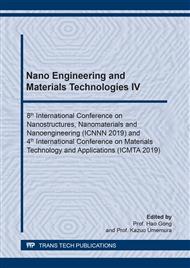p.283
p.291
p.296
p.302
p.306
p.312
p.318
p.325
p.330
A Performance Study of CNT/TiO2/ PVA Loaded on the Paper Filter for Benzene Treatment from Cigarette Smoke
Abstract:
This work has studied the performance of benzene treatment from cigarette smoke using the prepared CNT/TiO2/PVA loaded on the paper filter in the air purifier reactor. CNT/TiO2 nanomaterial was prepared from a mixture of carbon nanotubes modified with sulfuric acid and titanium dioxide by a simple mixing method in the ambient temperature. CNT/TiO2 nanomaterial was then loaded on the paper filter by a filtrating technique using 12%w/v polyvinyl alcohol (PVA) as a co-polymer. The weight of CNT/TiO2 loaded on the paper filter was fixed at 3 g. The ratios of CNT: TiO2 was varied at 1:5, 1:10, and 1:15 w/w, respectively. The performance of air purifier using CNT/TiO2/PVA loaded on the paper filter with various ratios was investigated on the photocatalytic activity of benzene treatment from cigarette smoke under visible light. The decreased benzene concentrations were analyzed by GC-FID. As the results, the ratio of CNT/TiO2 loaded on the paper filter at 1:10 showed the highest performance by up to 45%, while the ratio of CNT/TiO2 at 1:15 showed 30% and CNT/TiO2 at 1:5 was the lowest of 22%, respectively. This is because adding the optimum CNT to TiO2 can be improved the adsorption efficiency and the ability to degrade benzene from cigarette smoke. Additionally, CNT also assists in reducing the recombination of TiO2 particles that effect to the high performance on the photocatalytic activity. Therefore, the prepared CNT/TiO2/PVA loaded on the paper filter could be used for the air treatment.
Info:
Periodical:
Pages:
312-317
Citation:
Online since:
May 2020
Authors:
Keywords:
Price:
Сopyright:
© 2020 Trans Tech Publications Ltd. All Rights Reserved
Share:
Citation:


